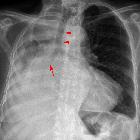Bronchogenic adenocarcinoma
 ähnliche Suchen
ähnliche SuchenBronchogenic adenocarcinoma
invasive adenocarcinoma of lung
Invasive adenocarcinoma of lungs
Invasive adenocarcinoma of the lungs
Invasive adenocarcinoma of the lung
Adenocarcinoma of lungs
Adenocarcinoma of the lungs
Adenocarcinomas of lung
Adenocarcinomas of the lung
adenocarcinoma of the lung
Lung adenocarcinomas
Pulmonary adenocarcinomas
adenocarcinoma of lung
pulmonary adenocarcinoma
pulmonales Adenokarzinom
Lung adenocarcinoma
 siehe auch
siehe auchAdenocarcinoma of the lung is the most common histologic type of lung cancer. Grouped under the non-small cell carcinomas of the lung, it is a malignant tumor with glandular differentiation or mucin production expressing in different patterns and degrees of differentiation.
This article brings a broad view over lung adenocarcinoma, for further details on each subtype, please refer to the specific articles listed below.
Terminology
In 2011, the International Association for the Study of Lung Cancer (IASLC), American Thoracic Society (ATS), and European Respiratory Society (ERS) introduced a new classification and terminology for adenocarcinoma of the lung, which is now divided into:
- preinvasive adenocarcinoma lesions
- minimally invasive adenocarcinoma
- invasive adenocarcinoma - invasive adenocarcinoma of the lung
- lepidic predominant adenocarcinoma of the lung
- formerly non-mucinous bronchioloalveolar carcinoma (BAC)
- acinar predominant adenocarcinoma of the lung
- papillary predominant adenocarcinoma of the lung
- micropapillary predominant adenocarcinoma of the lung
- solid predominant adenocarcinoma of the lung with mucin production
- variants of invasive adenocarcinoma
- invasive mucinous adenocarcinoma (formerly mucinous BAC)
- colloid - colloid adenocarcinoma of the lung
- fetal (low and high grade) - fetal adenocarcinoma of the lung (FLAC)
- enteric - enteric adenocarcinoma of the lung / primary pulmonary enteric adenocarcinoma
- lepidic predominant adenocarcinoma of the lung
Epidemiology
It is now considered the most common histological subtype in terms of prevalence, causing 38.5% of all cases .
Clinical presentation
Early symptoms are fatigue with mild dyspnea followed by a chronic cough and hemoptysis at a later stage.
Pathology
Lung adenocarcinoma is primarily categorized on the basis of histopathologic evaluation, although testing for genetic mutations (e.g. EGFR, KRAS) is becoming increasingly important for consideration of therapy .
- preinvasive adenocarcinoma lesions
- atypical adenomatous hyperplasia (AAH)
- localized small cell proliferation, usually ≤0.5 cm
- histological pattern: a focal proliferation of mildly to moderately atypical type II pneumocytes and/or Clara cells that line along the alveolar walls, alveolar septae, or respiratory bronchiole
- adenocarcinoma in situ (AIS)
- localized adenocarcinoma of ≤3 cm
- histological pattern: no growth pattern other than lepidic, with neoplastic cells along with the alveolar structures but without stromal, vascular, or pleural invasion, and no features of necrosis
- has a number of subtypes: the most common subtype is non-mucinous and, rarely, mucinous or mixed subtypes
- atypical adenomatous hyperplasia (AAH)
- minimally invasive adenocarcinoma
- localized adenocarcinoma of ≤3 cm
- histological pattern: either pure lepidic or predominant lepidic growth pattern, with neoplastic cells along with the alveolar structures with ≤5 mm of stromal invasion. These lesions should not show necrosis, lymphatic, vascular, or pleural invasion.
- three histopathological subtypes are recognized:
- non-mucinous: by far the most common subtype
- mucinous: goblet cell (mucus-secreting), often multicentric, rare
- mixed
- invasive adenocarcinoma (>5 mm invasion) - further subcategorization is recommended according to the dominant histologic pattern
- lepidic predominant adenocarcinoma of the lung
- formerly non-mucinous bronchioloalveolar carcinoma (BAC)
- acinar predominant adenocarcinoma of the lung
- papillary predominant adenocarcinoma of the lung
- micropapillary predominant adenocarcinoma of the lung
- solid predominant adenocarcinoma of the lung with mucin production
- variants of invasive adenocarcinoma
- invasive mucinous adenocarcinoma (formerly mucinous BAC)
- colloid - colloid adenocarcinoma of the lung
- fetal (low and high grade) - fetal adenocarcinoma of the lung (FLAC)
- enteric - enteric adenocarcinoma of the lung / primary pulmonary enteric adenocarcinoma
- lepidic predominant adenocarcinoma of the lung
Radiographic features
Often it is impossible to radiographically distinguish between other histological lung cancer types.
A lung nodule is a rounded or irregular region of increased attenuation. The amount of attenuation can further classify the nodules as either ground glass, subsolid or solid .
Histologically, the ground-glass attenuation corresponds to a lepidic growth pattern and the solid component corresponds to invasive patterns. Hence, the preinvasive category of adenocarcinoma in situ, minimally invasive adenocarcinoma, and the invasive subtype of lepidic-predominant adenocarcinoma are often seen as a ground-glass nodule or a subsolid nodule with a predominant ground-glass component. On the other hand, the remaining invasive subtypes of adenocarcinoma usually manifest as a solid nodule but may also be subsolid and are only occasionally seen as ground-glass nodule .
The invasive mucinous adenocarcinoma subtype (formerly mucinous BAC) can have a variable appearance, including consolidation, air bronchograms, or multifocal subsolid nodules or masses .
Nuclear medicine
FDG PET/CT
FDG-PET/CT is nowadays an essential tool for the lung cancer staging, in particular, assessing for the nodal and distant metastatic disease
adenocarcinoma in situ, low-grade adenocarcinomas, and minimally invasive adenocarcinoma are commonly associated with PET false-negative results. Given resolution limitations, FDG PET/CT is recommended when assessing subsolid ground-glass lung lesions that have a solid component measuring more than 8 mm
PET/CT definition of the gross tumor volume is commonly smaller than on CT, in ~15% of patients , therefore the T component of the TNM staging must be measured on CT or updated by the pathological staging
blooming artifact usually makes PET/CT less reliable to assess chest wall or diaphragmatic invasion
Treatment and prognosis
There are society guideline recommendations for the imaging follow-up of both ground glass and solid nodules: Fleischner Society guidelines .
Siehe auch:
- Lungenkarzinom
- Lungenrundherd
- In Situ Adenokarzinom der Lunge
- minimally invasive adenocarcinoma of the lung
- non-small cell carcinomas of the lung
- classification for adenocarcinoma of lung
und weiter:
 Assoziationen und Differentialdiagnosen zu Adenokarzinom der Lunge:
Assoziationen und Differentialdiagnosen zu Adenokarzinom der Lunge:


























